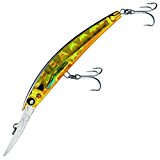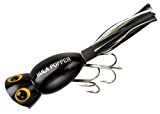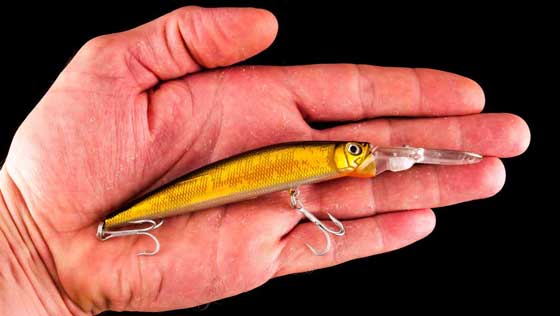Plugs and Poppers

What are fishing plugs?
Fishing plugs are a hard-bodied lure that are also known as crankbaits, wobblers, shallow-divers and deep-divers. These plugs are designed to imitate fish, frogs and other prey that are known for their diving abilities.
- We’ve had a high success rate using plugs for bass fishing and strongly recommend these for beginners or if you’re teaching children.
Most plugs have a body made of light wood or plastic with a thin sheet metal or plastic lip attached to the front of the body. This is sometimes adjustable to change the diving ability and wobbling movements of the lure. It’s adorned with as many as 2 or 3 treble hooks, but can sometimes come with double hooks.
Swimming Plugs
Swimming plugs wiggle as they’re pulled through the water and when at rest, they’ll either float or sink, dependent on their design.
- The best way to use these lures is to cast out and then reel them in using varying actions like changing the speed. Change their movement by jerking or yanking the rod.
*We recommend fishing minnows, and flat fish. If you’ve never tried these plugs, we suggest giving them a try as we’ve had great success with them.
Target: Largemouth Bass, Smallmouth Bass, Stripers and Walleye
 Floating Divers
Floating Divers
A contradiction of terms, but it makes sense and helps novice anglers to remember how it works. They float when at rest, but dive down when they’re being reeled in. They work well and can dive down to 12 feet without any problems. (This depends on their rated depth.) However, to get deeper than 12 feet, they’ll often need added weight.
How to use: The best technique for using diver lures involves diving them down and bouncing them off the floor bed.
Darter lures
 Darter is actually a brand name owned by the Greek Chub Bait Company. They float at rest and when they’re being reeled in, they stay just beneath the surface.
Darter is actually a brand name owned by the Greek Chub Bait Company. They float at rest and when they’re being reeled in, they stay just beneath the surface.
Fishing with darters: When reeling in a darter lure, don’t do so fast, but at a slow or moderate pace. This causes the wobbling action of the lure that’s attractive to the fish rather than scare them off.
- Best for Striped Bass.
These lures work very well for any fish that’s built for manoeuverability over speed.
 Popper lures
Popper lures
Popper lures are excellent lures, but take some experience to get the results that seasoned anglers get. This is one of those lures that does what it’s name implies: it makes a popping sound.
How to use: At rest, the popper will float. Make sure to float the popper between pops. Once the water ripples have died away, pop and then wait again, repeat until you have a strike.
Surface plug fishing
 This is a broad category of lures as it includes any surface running plug that disturbs the water by creating small waves or ripples. For the best use of surface plugs we recommend using the lure on calm water days with a slight ripple, but not with any waves. Just the ripples that a slight breeze may cause.
This is a broad category of lures as it includes any surface running plug that disturbs the water by creating small waves or ripples. For the best use of surface plugs we recommend using the lure on calm water days with a slight ripple, but not with any waves. Just the ripples that a slight breeze may cause.
- Good lure for Peacock Bass
Chugger Lures
 Chuggers are reeled in with a constant reel without any movement caused by the rod tip. A good and effective chugger is the Crazy Crawler. They’re easy to use and don’t require a lot of experience.
Chuggers are reeled in with a constant reel without any movement caused by the rod tip. A good and effective chugger is the Crazy Crawler. They’re easy to use and don’t require a lot of experience.
How to use: Simply cast the chugger out and reel it in and it’ll work.
Best use: A chugger lure is also effective night lure.
Stick Baits
Unlike the chugger, the stick baits do require some action on part of the angler to the rod tip. They’re simple lures that can resemble sticks or fairly bulky bomb shaped objects. They float at rest.
How they work: When they’re in motion, they hover just beneath the surface. They’re easy to use, and with experience they replicate most fish movements.
Propeller Plugs
Propeller plugs, as their name implies, are equipped with propellers at the forward section and rear, fore and aft. The forward prop is opposite that of the aft prop in order to keep the lure balanced and prevent torque. Fish are attracted to them due to the sound they emit through vibrations of the props.
Tip: A good propeller plug is the Arbogast Dasher.
 Jerk Baits
Jerk Baits
Jerk baits are underwater plugs. They don’t have any natural movement built into them and rely on the movement imparted by the angler.
How they work: As the name suggests you need to ‘jerk’ the rod. This action comes from the tip of the rod rather than from the reel. On a steady retrieval, they emit sonic waves when jerked as they’re moved through the water. They’re very effective at causing strikes as the action excites the fish.
Note: This is a lure that takes experience to get the most out of it.
- Best lures for smallmouth bass fishing and any sport fishing walleye, trout, bass.
Jump Baits
Jump baits are essentially jigs and plugs and can be fished vertically like jigs.
However, they are excellent for plunging to depths.
Click on this link for more information about jigs.
Vibrating Lure
![]() There’s a fine line between vibrating lures and other jigs. However, their vibrations are enough to consider them for a separate sub category. They’re made with plastic and are often slab shaped.
There’s a fine line between vibrating lures and other jigs. However, their vibrations are enough to consider them for a separate sub category. They’re made with plastic and are often slab shaped.
- Best lure for trolling, casting or even used for deep diving by allowing them to sink.
How to use: Vibrating lures don’t have much swimming action. The only way to make them move is through the angler’s twitching on their rod tip. Tight movements will emit high-frequency sonic waves similar to those in stunned baitfish, which easily captures the fish’s attention.





